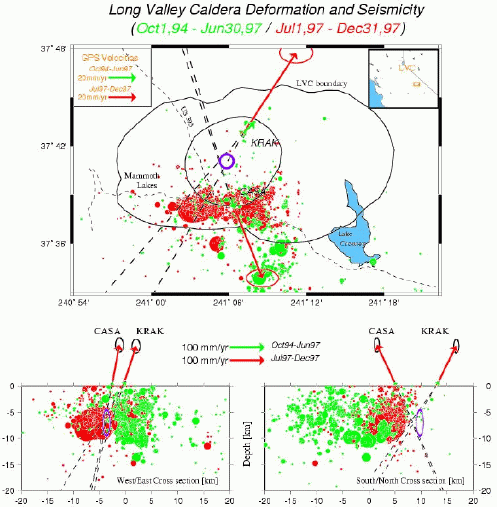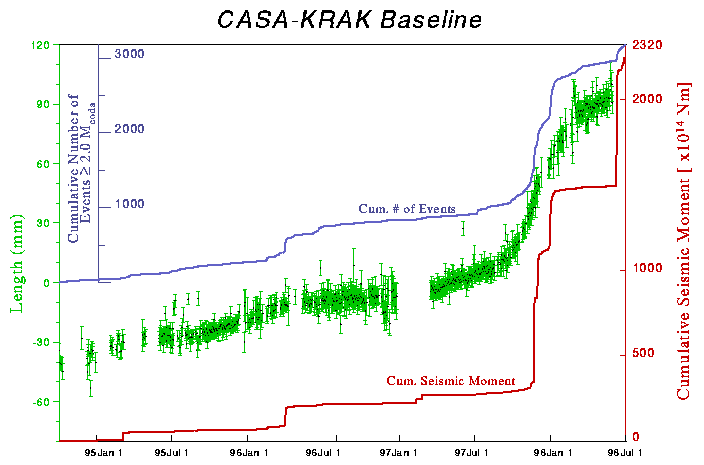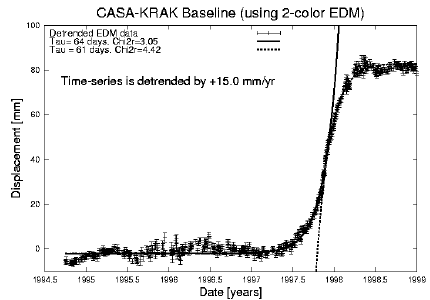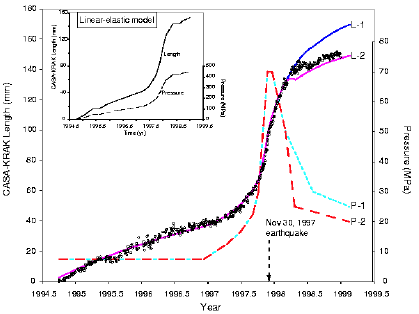Deformation modeling at Long Valley caldera
Andrew V. Newman
|

*click on illustration for a larger view
180 degree view of Long Valley Caldera in Eastern California. Composite photo taken from atop the western caldera wall in July 1997.
|
|
With Tim Dixon and Jackie Dixon (University of Miami) and Goodluck Ofoegbu (Southwest Research Institute)
I have been working on a project to better determine
geometric and rheologic constraints of active volcanic
processes on surface deformation. We are using mathematic
and numeric modeling to include the effects of
viscoelasticity on exponential characters of deformation
from a varying pressure source
at Long Valley caldera in east-central California.
Currently, we are writing proposals to further this
study by including both more complex geometries to better explain the nature of
this highly silicic, stratified magma source.
By better understanding the impact of rheology and magma source geometry on surface
deformation we will be able to be able to better predict volcanic eruptions.
With recent improvements in GPS, and SAR
interferometry technologies, this field of volcano geodesy is sure to grow and I am very
pleased to have become a part of this small, but
rapidly growing group.
|
|
Below are a few figures to help explain some of the work that we have
so for on this project.
|

*click on illustration for a larger view
|
[Top] Map of deformation and seismicity at Long Valley
caldera in eastern California (inset shows location) for two
different time periods, color-coded. Geodetic sites CASA and KRAK on
central resurgent dome shown as triangles. Deformation rate (arrows
with 95% confidence ellipses) and seismicity scaled by magnitude
(filled circles) shown for low activity period in green (October
1994 - June 1997) and high activity period in red (July
1997 - December 1998). Dashed-lines show the projected intersection
point for the GPS data. Open circle between CASA and KRAK shows
location and 95% confidence limits of shallow deformation source for
the period 1989-1992 described by Langbein et al. (JGR 100, 1995).
[Bottom-left] west-east and [Bottom-right] south-east cross
sections are displayed, to illustrate depth range of seismicity and
vertical component of surface deformation. Small green arrows
at base of red arrows represent GPS velocity for the earlier time period. |

*click on illustration for a larger view
|
Scalar length between CASA and KRAK measured by GPS minus
an arbitrary constant, compared to cumulative seismic moment and
cumulative number of seismic events with Mcoda >= 2.0
for the period October 1994 to June 1998.
|

*click on illustration for a larger view
|
Scalar length between CASA and KRAK measured by two color
EDM, detrended by 15 mm/yr, with exponential fits for early (increasing
deformation rate) and later (decreasing deformation rate) periods.
|

*click on illustration for a larger view
|
Observed length (two color EDM) between CASA and KRAK
minus an arbitrary constant (small open circles) between late 1994
and early 1999, compared to predicted length (solid lines, L-1 and
L-2) from a viscoelastic shell model calculated by a finite element
model approach. Model assumes a spherical source of incremental
pressure at 6 km depth and 500 m radius, surrounded by a Maxwell
viscoelastic shell 1.0 km thick with viscosity 1016 Pa s, embedded in
an elastic half space. Light dashed lines (P-1 and P-2) are assumed
source pressure history (right hand scale). Arrow shows time of
maximum seismic moment release (November 30, 1997) during this
period.
[Inset] shows equivalent purely elastic half space model
(i.e., no viscoelastic shell), note higher pressure increments
required to match data.
|
For more information on this project please read:
- Newman, A. V., T. H. Dixon & N. Gourmelen, A Four-Dimensional Viscoelastic Model
for Deformation of the Long Valley Caldera, California, between 1995 and 2000,
Journ. of Volcan. and Geoth. Res., [In Press].
Download PDF version
- Newman, A. V., T. H. Dixon, G. Ofoegbu & J. E. Dixon, Geodetic and Seismic Constraints
on Recent Activity at Long Valley Caldera, California: Evidence for Viscoelastic Rheology
Jour. of Volcan. and Geoth. Res., 105 3, 183-206, February 2001.
Download PDF version
|
Current Research |
Curriculum Vitae |
Sites of interest |
Home
anewman gatech.edu | Updated:
Sun Nov 5 13:47:07 EST 2006 gatech.edu | Updated:
Sun Nov 5 13:47:07 EST 2006
|
 gatech.edu | Updated:
Sun Nov 5 13:47:07 EST 2006
gatech.edu | Updated:
Sun Nov 5 13:47:07 EST 2006
 gatech.edu | Updated:
Sun Nov 5 13:47:07 EST 2006
gatech.edu | Updated:
Sun Nov 5 13:47:07 EST 2006